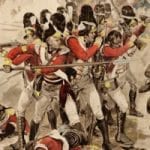The Battle of Alexandria
On March 21st 1801 a battle was fought outside Alexandria which resulted in the 28th (North Gloucestershire) Regiment being awarded a unique distinction. The army was led by General Sir Ralph Abercrombie and the 28th were part of the Reserve Division under the command of Major General Sir John Moore, occupying an unfinished redoubt in advance of a key position of the British defences. Thus exposed on low sandhills by the sea shore, they were subject to the full brunt of the French attacks. In one of these attacks the 28th were simultaneously attacked front and rear, but due to their steadiness and their devastating volleys they managed to turn the battle at a crucial time and inflict a significant defeat on the French for the first time in 30 years. Like Wolfe before him, Abercrombie was to die in the hour of his greatest victory. The gallant action of the 28th has been commemorated by the privilege of wearing the emblem of the Egyptian Sphinx on the back of the headdress. To this day, 21st March is known as Back Badge Day and celebrated accordingly.
Sergeant Joseph Coates of the 28th described the action in his memoir of the Egyptian campaign. (It should be noted that Coates ascribes the famous order to Colonel Paget, although, since Paget had been wounded in the throat, it is perhaps more likely that it was his second in command, Lieutenant Colonel William Chambers, who gave the order).
“… The French charged in three columns, the left of which came round the left flank of our regiment, over the ground which the 42d regiment had left, to charge it in the rear, whilst it was warmly assailed by the infantry in front, and just as this column was making the turn to come upon our rear, they overtook me. At that time Colonel Paget ordered the regiment to the right about, and firing a volley as the enemy came within a few horse lengths, occasioned a most dreadful carnage; such a quantity of horses falling from the fire, occasioned many others to stumble, and fall upon them, the others were thrown into complete disorder, and made all speed to return. In joining my regiment I had to jump over several of the enemy’s dead horses and men, and turning around, was astonished at the execution which had so instantaneously been done. After the volley the 28th faced about again and resumed their fire on their assailants in front, such as had ammunition; but many having now expended it all, resulted to throwing of stones, and, indeed, some of the enemy had recourse to the same weapons.”
The 61st (South Gloucestershire) Regiment was also involved in the Egyptian Campaign. In 1801 they were sent to India but were diverted to Egypt to take part and, after landing at Kosseir on the Red Sea, marched 130 miles across the desert to the Nile in nine days with the loss of only one man. Although they arrived too late to play an active role against the French Army, the Regiment was awarded Egypt as a a battle honour and the right to wear the Sphinx on its badge.
While at Alexandria, Captain Leighton of the 61st described in two letters home, dated 20th January and 4th February 1802, the attempts to remove the ancient obelisk known as Cleopatra’s Needle, which now stand on the Thames Embankment in London:
“… We have a good deal of duty here. Besides the guards, there are four Captains, sometimes six, employed in a day in taking charge of the working parties for the removal of the Needle. A Wharf is to be constructed, which will put about 90 yards into the sea; The nearest point where a ship can anchor in. there are people who doubt the practicability of the scheme. As we have gone so far I confess I feel anxious it should succeed.”
“… In my last letter I mentioned that we were endeavouring to send home the fallen needle stone of Cleopatra; and that the means taken to embark it were a pier of considerable length: which was about half finished when one stormy night destroyed almost the whole of our labour. That method is now laid aside, & they are going to embark it on a large raft constructed for the purpose. The weight of the stones is supposed to be about 200 tons. You would find great amusement in hunting among the old ruins for antiquities. The whole of the ground for some miles to both Eastward and Westward of this place is entirely covered with ruins. Many pillars and foundations of buildings are seen in the sea, but not very distant from the shore.”
Both attempts were to end in failure and Cleopatra’s Needle had to wait until 1877 before leaving Egypt to find a new home in London the following year.
Picture: The 28th Foot at Alexandria.


